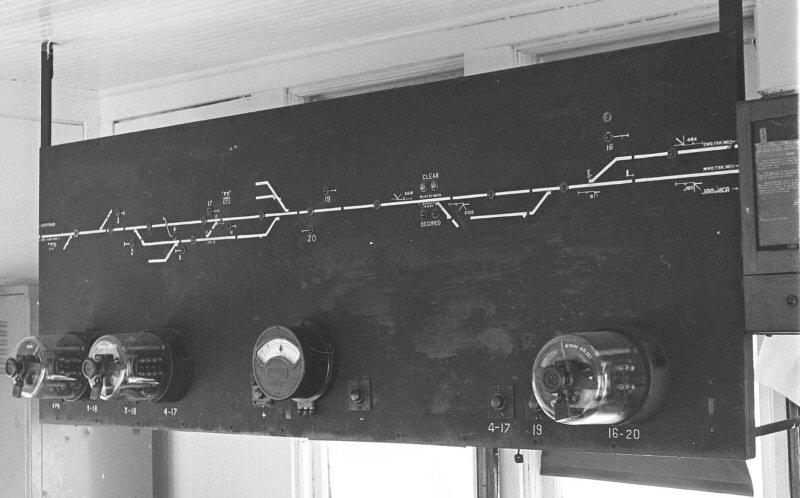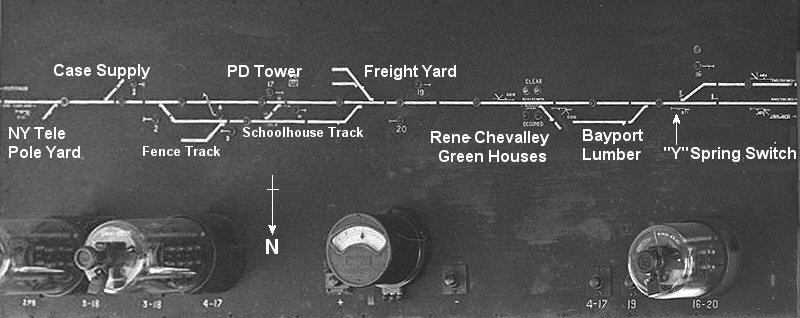That was the board for when the strong-arms were in service. It was followed up by a small unit lever machine, I believe was crafted on the property, which fit on the desk on the opposite wall (facing the tracks). Later, they interlocked MS (now JJD) and that machine was placed next to the unit lever machine. And for a long time, that was it, the PD machine (Y switch was interlocked then and added to the PD control panel), BO block limit, MS, and then the rest of the block limits.
This board, faced the side on the parking lot, which explains why it is upside down, compared to the follow-up machine. The meter is some sort of voltmeter or ammeter, and it has two buttons, one for + reading and one for negative. I'm not sure why they set it up like that, maybe someone else can chime in. Numbers - every signal and switch was numbered in an interlocking, usually matching a lever on the interlocking machine. Sometimes they followed a convention of giving sigs even numbers and switches odd, but that depended on the location. Also not seen in this pic with many strong-arm machines, buttons on the floor which had to be stepped on before you could throw an unlock lever. This had something to do with the "detector", which checked for wheel flanges before permitting a throw. Some strong arms did it with the squeeze lever, and that had a midpoint that could be touchy to find, you'd have to listen for a buzz or relay to pick to get it right.
The glass jar things are "screw releases" or timers which permit an operator to put a signal back if there is a train on the circuit. It's a safety device which keeps the operator from dropping a signal in the engineer's face and then throwing a switch under a moving train. What is supposed to happen is the operator gets permission from the engineer via radio to take it back (implying that the engineer will stop short of the signal, or if stopped won't move. Prior to radio, whistle/horn signals were used), and once that's received the operator can activate the timer using the dial on the front of the jar. Then a noisy timer goes off and after it "runs time", the machine will permit the operator to restore the signal and THEN throw switches to change the route. The glass jar is locked and only the maintainer has a key to unlock the jar and then clean the "fingers" or contacts which do this. Each signal is assigned one (can be more than one signal to a release) and the timer length is determined by the MAS (max speed) on that portion of track. So, a siding or yard track signal would be much less than one on the main.
The buttons nearby were "punch" buttons which would "call-on" a signal, causing it to display it's most restrictive aspect. This was used in following movements, or putting a engine on it's train, or dealing with a track circuit failure.
Between the Y and PD is a pair of circuits and where they meet has "clear/occupied" lights. Now, I'm not sure what that portion of rail's rules were. When the newer machine mentioned above came online, between Y and PD was manual block/Rule 261, meaning there was direction of traffic, but only one train in the block at a time. This is different, and I'm guessing they had to have both bulbs lit "clear" before they could get the signals into that portion of rail. I did hear an old-timer say that at one time you had to give out A-Cards for PD/Y (a PITA considering the workload was like back then), so that may have been tied into that. If Dave Keller or a retiree could chime in, that would be great. Some of the older Mainline towers (SG, etc) did have the option to display a "permissive block", wherein a freight of certain size could follow another train in a manual block at restricted speed, perhaps those lights were for that too.
Nice pics! Except for the freight yard (Patchogue team), all of those sidings were gone, and then later they extended PD, by lengthening the Schoolhouse and trailing the fence into, and then the Schoolhouse trails into the main now at PD2. Where the Schhse track is painted on the board, that is now considered the North Track, west from the cross-over by the tower.
Last edited by krispy on Tue Aug 11, 2020 7:41 pm, edited 1 time in total.



